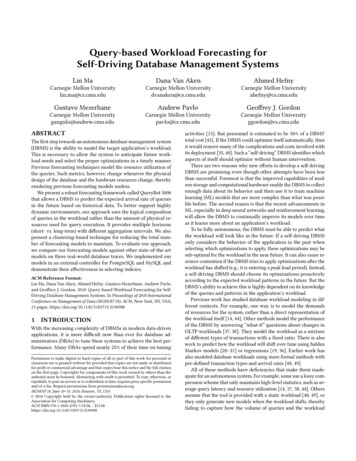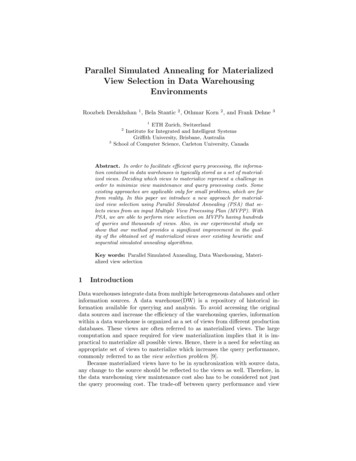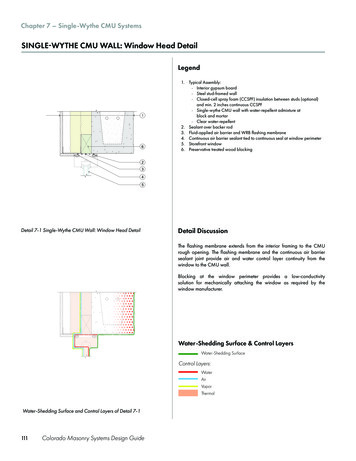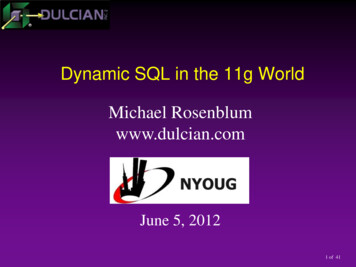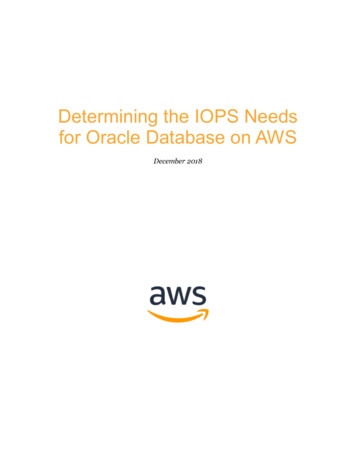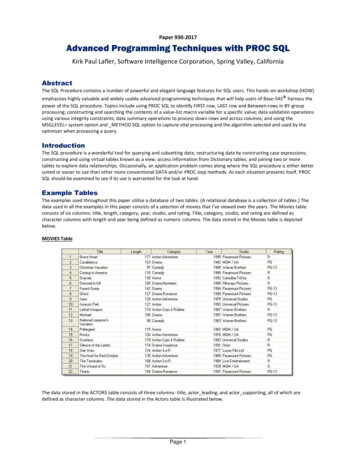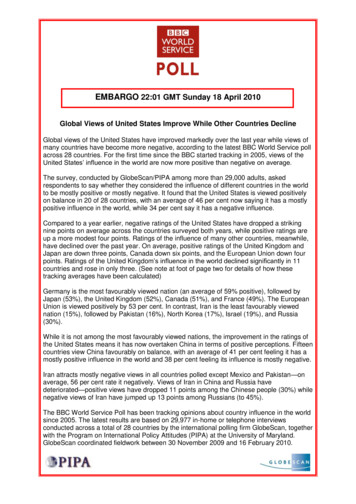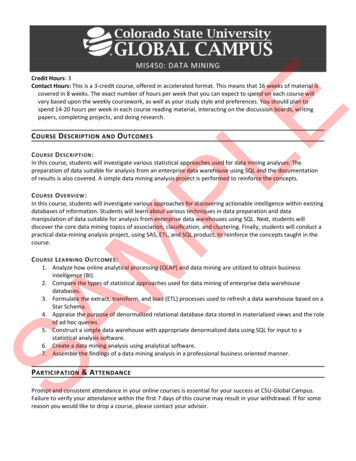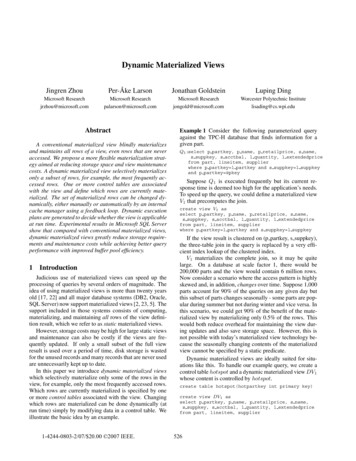
Transcription
Dynamic Materialized ViewsJingren ZhouPer-Åke LarsonJonathan GoldsteinLuping DingMicrosoft Researchjrzhou@microsoft.comMicrosoft Researchpalarson@microsoft.comMicrosoft Researchjongold@microsoft.comWorcester Polytechnic Institutelisading@cs.wpi.eduAbstractA conventional materialized view blindly materializesand maintains all rows of a view, even rows that are neveraccessed. We propose a more flexible materialization strategy aimed at reducing storage space and view maintenancecosts. A dynamic materialized view selectively materializesonly a subset of rows, for example, the most frequently accessed rows. One or more control tables are associatedwith the view and define which rows are currently materialized. The set of materialized rows can be changed dynamically, either manually or automatically by an internalcache manager using a feedback loop. Dynamic executionplans are generated to decide whether the view is applicableat run time. Experimental results in Microsoft SQL Servershow that compared with conventional materialized views,dynamic materialized views greatly reduce storage requirements and maintenance costs while achieving better queryperformance with improved buffer pool efficiency.1 IntroductionJudicious use of materialized views can speed up theprocessing of queries by several orders of magnitude. Theidea of using materialized views is more than twenty yearsold [17, 22] and all major database systems (DB2, Oracle,SQL Server) now support materialized views [2, 23, 5]. Thesupport included in those systems consists of computing,materializing, and maintaining all rows of the view definition result, which we refer to as static materialized views.However, storage costs may be high for large static viewsand maintenance can also be costly if the views are frequently updated. If only a small subset of the full viewresult is used over a period of time, disk storage is wastedfor the unused records and many records that are never usedare unnecessarily kept up to date.In this paper we introduce dynamic materialized viewswhich selectively materialize only some of the rows in theview, for example, only the most frequently accessed rows.Which rows are currently materialized is specified by oneor more control tables associated with the view. Changingwhich rows are materialized can be done dynamically (atrun time) simply by modifying data in a control table. Weillustrate the basic idea by an example.1-4244-0803-2/07/ 20.00 2007 IEEE.Example 1 Consider the following parameterized queryagainst the TPC-H database that finds information for agiven part.Q1 :select p partkey, p name, p retailprice, s name,s suppkey, s acctbal, l quantity, l extendedpricefrom part, lineitem, supplierwhere p partkey l partkey and s suppkey l suppkeyand p partkey @pkeySuppose Q1 is executed frequently but its current response time is deemed too high for the application’s needs.To speed up the query, we could define a materialized viewV1 that precomputes the join.create view V1 asselect p partkey, p name, p retailprice, s name,s suppkey, s acctbal, l quantity, l extendedpricefrom part, lineitem, supplierwhere p partkey l partkey and s suppkey l suppkeyIf the view result is clustered on (p partkey, s suppkey),the three-table join in the query is replaced by a very efficient index lookup of the clustered index.V1 materializes the complete join, so it may be quitelarge. On a database at scale factor 1, there would be200,000 parts and the view would contain 6 million rows.Now consider a scenario where the access pattern is highlyskewed and, in addition, changes over time. Suppose 1,000parts account for 90% of the queries on any given day butthis subset of parts changes seasonally - some parts are popular during summer but not during winter and vice versa. Inthis scenario, we could get 90% of the benefit of the materialized view by materializing only 0.5% of the rows. Thiswould both reduce overhead for maintaining the view during updates and also save storage space. However, this isnot possible with today’s materialized view technology because the seasonally changing contents of the materializedview cannot be specified by a static predicate.Dynamic materialized views are ideally suited for situations like this. To handle our example query, we create acontrol table hotspot and a dynamic materialized view DV1whose content is controlled by hotspot.create table hotspot(hotpartkey int primary key)create view DV1 asselect p partkey, p name, p retailprice, s name,s suppkey, s acctbal, l quantity, l extendedpricefrom part, lineitem, supplier526
where p partkey l partkey and s suppkey l suppkeyand exists(select * from hotspot hswhere p partkey hs.hotpartkey)Query Q1Case 2:Using TablesCase 1:Using 9.Base TablesDBARecordEventNew hotkeysCache ManagerFigure 1. Overall ArchitectureWhile the static view V1 materializes information aboutall parts, DV1 only materializes information about the partslisted in the control table hotspot, that is, parts satisfyingthe exists clause. The control table is invisible – queries donot need to explicitly reference the control table to exploitthe view.Figure 1 outlines the overall architecture of using dynamic materialized views in a database system. Query Q1can be answered from the view if the key of the desired partis found in hotspot. To exploit the view safely, the optimizer produces a query plan that first checks at run-timewhether the desired part key exists in hotspot, shown asstep ① in Figure 1. If it does, the plan evaluates the queryusing a simple select against DV1 (step ②). Otherwise, thequery is evaluated using the base tables (step ③).Upon updates to the base tables, only changes affectingthe hot parts need to be propagated to DV1 , which greatlyreduces the view maintenance cost. The content of DV1can be changed dynamically by updating the control tablehotspot. Inserting a new part key into the control tableautomatically adds its information to the view. The deletions happen in a similar way. We delay discussion of incrementally maintaining dynamic materialized views untilSection 2.Figure 1 also shows two possible ways to manage thecontent of DV1 . A DBA can manually change the contentsof the control table according to new business requirements(step ④). Or, the control table can be automatically managed by an internal cache manager using a feedback loop.During execution of Q1 , the cache manager records whetherthe query could be answered from the view or not (step ⑤).The cache manager implements some caching policy andrecommends admitting or evicting rows in the control table based on its policy (step ⑥). The recommended updatesof the control table are done asynchronously so that normalquery execution is not affected1 .Dynamically materializing only part of a view can beuseful in many scenarios. For example, dynamic views canbe extremely useful for a mid-tier database cache [16, 1, 8],1 Theupdate process is not shown in the figure.1-4244-0803-2/07/ 20.00 2007 IEEE.where the replicated data can be treated as dynamic materialized views and contain only the most frequently accessedrows. A dynamic view can also be used for incrementalview materialization. Conventionally, materialized viewscannot be exploited before the materialization finishes. Theprocess can be very lengthy for an expensive view. Beforethe view gets fully materialized, we can treat it as a dynamicmaterialized view and the contents of the control table represent the current materialization progress. As a result, theview can be exploited even before it is fully materialized!We discuss other potential applications in Section 4.The main contributions of our paper are as follows: We provide a new mechanism to dynamically adaptand exploit the contents of materialized views. Compared with traditional approaches, dynamic materialized views significantly reduce view maintenance costsand storage requirements. We extend conventional view matching and maintenance algorithms to dynamic materialized views. Dynamic query execution plans determine at run timewhether a view can be used or not. We introduce a feedback loop with a novel cachingpolicy to automatically adapt the contents of dynamicmaterialized views. We outline several potential applications of dynamicmaterialized views across different areas in databasesystems.The rest of this paper is organized as follows. In Section 2, we introduce the general form of a dynamic materialized view, and present view matching and maintenancealgorithms. We describe several types of control schemasand dynamic views with more complex control designs inSection 3. In Section 4, we explain how to adapt the contents of the dynamic view using a feedback loop and outlineother applications. Experimental results in Microsoft SQLServer are presented in Section 5. We review related workin Section 6 and conclude in Section 7.2 Dynamic Materialized ViewsIn this section, we define dynamic materialized viewsand describe how to extend regular view matching andmaintenance algorithms to work with dynamic materializedviews. For ease of presentation, we use a dynamic materialized view with a single control table as an example. Thetechniques presented here are also applicable to more advanced dynamic materialized views in Section 3.2.1View DefinitionsLet Vb denote the query expression defining a standardSPJG (select, project, join and an optional group-by) viewand Pv its select-join predicate. We refer to Vb as the baseview. Borrowing from SQL, we use the shorthand Vb . todenote all columns of view Vb .A dynamic materialized view Vd is defined over the baseview Vb but has materialization controlled by a control tableTc and a control predicate Pc (Vb , Tc ).527
create view Vd asselect Vb .* from Vbwhere exists (select 1 from Tc where Pc (Vb , Tc ))Control table Tc can be a regular table or even anothermaterialized view. Control predicate Pc references columnsfrom Tc and only non-aggregated output columns from Vb .This restriction is important for view matching and for viewmaintenance as described in Section 2.2 and Section 2.3.The exists clause in the definition restricts the rows actually materialized in Vd to those satisfying the control predicate Pc for rows currently stored in Tc . Hence, by addingand deleting rows from Tc , we control the contents of Vd .The dynamic materialized view DV1 defined earlier hasthe following components. We omit the full column list.Vb : select .from part, lineitem, supplierwhere p partkey l partkey and s suppkey l suppkeyPv :(p partkey l partkey) (l suppkey s suppkey)Tc : hotspot(hotpartkey int)Pc (Vb , Tc ): (p partkey hotpartkey)2.2View MatchingA view matching algorithm for regular materializedviews is described in [5]. A view can be used to answer thewhole query or some subexpressions. To determine whethera query expression can be computed from a view, the queryand view expressions are first converted into normal form.Next containment is tested, that is, whether all rows required by the query are contained in the view. Finally, additional requirements such as whether the view supplies allrequired columns and has the correct duplication factor arechecked. In this section, we show how to extend this algorithm to handle dynamic materialized views.For regular views, containment of the query in the viewcan be tested at optimization time but for dynamic materialized views, part of the testing has to be postponed to execution time. We call the test evaluated at execution time aguard condition. In this paper, we assume that guard conditions are limited to checking whether one or a few coveringvalues exist in the control table. If the desired values arefound in the control table, then all tuples associated withthose values are currently materialized.At optimization time, we construct the guard conditionso that the query is guaranteed to be contained in the viewif the guard condition evaluates to true. The evaluation ofthe guard condition is delayed until execution time. Thequery plan must also contain an alternative subplan, calleda fallback plan, that computes the query expression fromother input sources in case the guard condition evaluates tofalse.Figure 2 shows a possible dynamic query plan for Q1 .The ChoosePlan operator first evaluates the guard condition shown on the right. (The operator tree for evaluatingthe guard condition is not shown.) If it evaluates to true,the dynamic view contains the required rows and the leftbranch using the view is executed. Otherwise, the rightbranch computing the result from base tables is executed.1-4244-0803-2/07/ 20.00 2007 IEEE.TrueFalseGuard ConditionSELECTJOINp partkey @pkeyDV1exists (select 1 from hotspotwhere hotpartkey @pkey)ChoosePlanJOINSupplierUsing ViewSELECTp partkey @pkeyPartLineitemFallback planFigure 2. Dynamic execution plan for Q1More formally, let Vd be a dynamic materialized SPJview with base view Vb and control predicate Pc . Denotethe select-join predicate of Vb with Pv . Consider a SPJquery Q over the same tables as Vb and denote its combinedselect-join predicate by Pq . Due to space limitation, all theproofs are omitted and can be found in [24].Containment checking requires that Pq (Pv Pc ) inorder to answer Q from Vd . The control table is invisibleto the query so Pq does not reference the control table. Theimplication cannot be proven at compile time because it depends on the contents of the view at run time. To deal withthis, we break up the test into three parts; the first two areevaluated at optimization time and the third one – the guardcondition – is evaluated at execution time.The first part is Pq Pv , which tests whether the queryis contained in the view if it is fully materialized. Clearly,the query cannot be contained in a dynamic materializedview if it is not even contained in the corresponding fullymaterialized view.For the second part, we add a guard predicate Pg , if possible, to the antecedent, obtaining the condition (Pg Pq ) (Pv Pc ). This condition asks the question: “If the additional condition Pg is satisfied, is the query then containedin the view?” If the first condition, Pq Pv , is satisfied,this second condition can be simplified to (Pg Pq ) Pc .The third part of the test consists of verifying, at execution time, that a tuple satisfying the guard predicate existsin the control table, that is, t Tc : Pg (t).Theorem 1 Consider an SPJ query Q with a conjunctivepredicate Pq and a dynamic materialized SPJ view Vd withbase view predicate Pv , control predicate Pc , and controltable Tc . Then query Q is covered by view Vd if there existsa predicate Pg such that the following three conditions aresatisfied.Pq Pv(Pg Pq ) Pc t Tc : Pg (t)(1)(2)(3)Example 2 For our example view P V1 and query Q1 , it iseasy to see that the first test is true. Choosing the guardpredicate as (hotpartkey @pkey), the second test (Pg Pq ) Pc is simplified to(hotpartkey @pkey) (p partkey @pkey) (p partkey hotpartkey)It is easy to see that this condition is also true. The lasttest, to be evaluated at execution time, equals528
2.3 t hotspot:(t.hotpartkey @pkey)This condition, expressed in SQL, is shown in Figure 2.Whether the dynamic materialized view is guaranteedto contain all required rows depends on whether Pg , withknown parameters, evaluates to true at execution time. Thefollowing theorem considers queries with non-conjunctivepredicates.Theorem 2 Consider an SPJ query Q with a nonconjunctive predicate Pq , which can be converted to disjunctive normal form as Pq Pq1 · · · Pqn and a dynamic materialized SPJ view Vd with base view predicatePv and control predicate Pc referencing a control table Tc .Then query Q is covered by view Vd if, for each disjuncti 1, 2, · · ·, n, there exists a predicate Pgi such that thefollowing three conditions are satisfied.Pqi Pv(Pgi Pqi )(4) Pc(5) ti Tc : Pgi (ti )(6)View MaintenanceIncremental maintenance of materialized views is a wellstudied problem, and efficient maintenance algorithms areknown for SPJG views. Compared with a fully materialized view, a dynamic materialized view can be maintainedmore efficiently, because only a small number of rows areactually materialized. However, current view maintenancealgorithms are designed for SPJG views and do not supportviews containing exist subqueries. In this section, we outline how to incrementally maintain a dynamic materializedview. The general observation is that if the base view Vbis maintainable, the corresponding dynamic view Vd is alsomaintainable.If the query expression in the exists clause returns at mostone row for each possible value of the control columns, thesubquery can be converted to a join. A dynamic materialized view Vd that satisfies this requirement can, for maintenance purposes, be treated as the regular view Vd shownbelow.create view Vd asselect Vb .* from Vb , Tc where Pc (Vb ,Tc )Example 3 The following query is similar to Q1 but theequality predicate has been changed to an IN predicate.An IN predicate can be rewritten as a disjunction of equality predicates, which after conversion to disjunctive normalform, produces the two disjuncts shown below.The view Vd is a regular SPJG view and can be incrementally maintained. For example, the view DV1 is of thistype because hotpartkey is a primary key of the control tablehotspot. Converting the subquery to an inner join producesthe following equivalent definitionQ 1 :select .from part, lineitem, supplierwhere p partkey l partkey and s suppkey l suppkeyand p partkey in (12, 25)create view DV1 asselect .from part, lineitem, supplier, hotspotwhere p partkey l partkey and s suppkey l suppkeyand p partkey hotpartkeyPq1 :(p(sPq2 :(p(spartkey lsuppkey lpartkey lsuppkey lpartkey)suppkey)partkey)suppkey) (p partkey 12) (p partkey 15)The view matching tests for this example will be thesame as in Example 2, except @pkey is replaced by 12 orby 15. The optimization-time tests still evaluate to true. Forthe query to be covered, both execution-time tests must besatisfied, which produces the following guard condition. t1 hotspot:(t1.hotpartkey 12) t2 hotspot:(t2.hotpartkey 15)which can be expressed in SQL most efficiently as2 (select count(*) from hotspotwhere hotpartkey in (12,15))An aggregation query or view is treated as an SPJ queryfollowed by a group-by operation. Aggregation adds onestep to view matching that tests whether the grouping inthe view is compatible with that in the query. For a dynamic aggregation view the grouping-compatibility test isthe same as for a regular view because of our requirementthat the control predicate Pc of the view involves only nonaggregated output columns of the base view Vb . Hence, either all the rows in a group or none of them will satisfy thecontrol predicate.1-4244-0803-2/07/ 20.00 2007 IEEE.If the query expression in the exists clause may returnmore than one row, converting the subquery into a join mayproduce duplicate rows. We consider two situations basedon whether Vb contains aggregation.Case 1: First consider the case when Vb is a SPJ view.If the output columns of Vb contain a unique key 2 , we canconvert the view Vd into the following aggregation view Vd to make it incrementally maintainable.create view Vd asselect Vb .*, count(*) as cntfrom Vb , Tc where Pc (Vb , Tc ) group by Vb .*All the output columns of Vb have to be included asgroup-by columns so that they can be output. The group-byoperation in Vd simply removes the duplicated rows and thecount is added for view maintenance. The view Vd containsexactly the same rows as the view Vd ; the only difference isthat each row has an additional column cnt.If the output columns of Vb do not contain a unique key,an extra join is required during maintenance so as not tointroduce duplicates. We will show the rewrite assuming asingle control column and denote this column by Cc . Thegeneralization to multiple view columns is straightforward.We rewrite Vd using a self-join for maintenance purposes.2 In Microsoft SQL Server, a materialized view is required have aunique key.529
create view Vd asselect Vb .*from Vb v1 join(select Cc from Vb , Tcwhere Pc (Vb , Tc )group by Cc ) v2on (v1.Cc v2.Cc )The inner query removes duplicate rows. Although Vd isno longer a SPJG view, it can be maintained incrementally.During updates, the delta table of the inner query is computed first, including duplicate elimination, and then usedto update the outer view.Case 2: Now consider the case when Vb is an aggregation view. Let Vbspj denote the SPJ part of the view andG denote the group-by columns of the view. If the outputcolumns of Vbspj contain a unique key, we can rewrite Vd asfollows for maintenance purposes. The inner query removesduplicate rows before applying the aggregation in the outerquery.create view Vd asselect Vb .*from (select Vbspj .* from Vbspj , Tcwhere Pc (Vb , Tc ) group by Vbspj .*)group by GSimilarly, if the output columns of Vbspj do not contain aunique key, the inner query can by replaced by a self-join;the view can also be incrementally maintained.In summary, these rewrites show that dynamic views canbe efficiently maintained incrementally in the same way asregular views.3 Control SchemesSo far we show dynamic views with equality controlpredicates. But many other types of control predicates andcontrol tables are also possible. In this section, we cover afew important types, discuss what type of queries they cansupport and show how to construct the guard predicate Pg .Equality Control Tables: An equality control table isone where the control predicate specifies an equijoin between one or more columns in the base view and in thecontrol table. This type of control table can only support queries with equality constraints on all join columnsor queries that can be converted to this form. The controltable hotspot and the dynamic materialized view DV1 inSection 1 are of this type.Range Control Tables: A range control table is one thatsupports range control predicates. A dynamic materializedview with a range control table can support range queries orpoint queries.Example 4 Consider the following parameterized rangequery that finds information about all suppliers for a givenrange of parts, e.g. (p partkey @pkey1 p partkey @pkey2). To support the query we create a dynamic materialized view with a range control table.create table hotrange(lowerkey int, upperkey int)create view DV2 asselect . from part, lineitem, supplier1-4244-0803-2/07/ 20.00 2007 IEEE.where p partkey l partkey and s suppkey l suppkeyand exists (select * from hotrangewhere p partkey lowerkey and p partkey upperkey)For efficiency, one would ensure that hotrange containsonly non-overlapping ranges. This can be done by adding asuitable check constraint or trigger to the table.To guarantee that the view contains all required rows, thecontrol table must contain a range that covers the query’srange. Hence, the guard predicate becomesPg : (lowerkey @pkey1) (upperkey @pkey2)and the guard condition, expressed in SQL, becomesexists(select * from hotrangewhere lowerkey @pkey1 and upperkey @pkey2)Control tables specifying just an upper or a lower boundare feasible as well, and would support queries that specifya single bound, a range constraint, or an equality constraint.The control table would have only one row containing thecurrent lower (or upper) bound.Control Predicates on Expressions: The control predicate Pc is not limited to comparisons with “plain” columnsfrom the base view. The comparison may instead be appliedto the result of an expression or function over columns fromthe base view. Even a user-defined function can be used aslong as it is deterministic.Example 5 Suppose we have a user-defined function ZipCode that takes as input an address string and returns thezip code of the address. Consider the following query thatfinds information about all suppliers within a specified zipcode, e.g. ZipCode(s address) @zip.To support this query we define a control table hotzipcode and a dynamic view DV3 as shown below.create table hotzipcode(zipcode int primary key)create view DV3 asselect . from part, lineitem, supplierwhere p partkey l partkey and s suppkey l suppkeyand exists (select * from hotzipcode zcwhere ZipCode(s address) zc.zipcode)The guard predicate is the same as for an equality controlpredicate referencing a “plain” column.Pg : hotzipcode.zipcode @zipMore Elaborate Control Designs: A dynamic materialized view can have multiple control tables, and the controlpredicates for each table can be combined in different ways.For example, a dynamic materialized view can store information only for hot parts defined in a control table hotpartand hot suppliers defined in another control table hotsupplier. A query that ask information for a given part and agiven supplier can exploit the view with a run-time guardconditionexists(select 1 from hotpart where hotpartkey @pkey)and exists(select 1 from hotsupplierwhere hotsuppkey @skey)More interestingly, different dynamic materialized viewsmay share a common control table. The same control table controls the contents of all the views. Moreover, a (dynamic) materialized view can be used as a control table todefine another dynamic materialized view.530
satisfied all our requirements. All of them always admita new key on its first access, ignoring the cost of the admission and possible an eviction as a consequence. In thecase of dynamic views, admissions to the control table recreate table hotsegments(segm varchar[25] primary key) sults in execution of a query and insertion of the result intothe view. Evictions from the control table cause deletionscreate view DV4 asfrom the view. The costs of admissions cannot be ignored.select . from customerTherefore, we need a cache policy that has a low admiswhere exits(select * from hotsegmentssion/eviction rate combined with a high hit rate. Becausewhere c mktsegment segm)the cache controller is in memory, the cache policy needs tocreate view DV4 asbe very space efficient too.select . from ordersWe designed a novel cache policy based on the 2Q algowhere exists (select * from DV4where o custkey c custkey)rithm [14]. Due to space limitation, we can only highlightthe important features of the algorithm.The two views can of course be used independently, thatis, DV4 for queries against the customer table where the Similar to the 2Q algorithm, we make use of twomarket segment is specified and DV4 for queries against thequeues, one for admissions and one for evictions.orders table where the customer key is specified. In addition We consider admission of a new row on its second andthey can be used for queries joining customer and orderssubsequent accesses.that specify a market segment, e.g. the following query. We keep track of the approximate temperature (timeselect . from customer, orderssince last access) of every row in both queues.where c custkey o custkey and c mktsegment ’Household’ If the cache is full, a row is admitted only of it is hotterDynamic views with other powerful and flexible controlthan the coolest row already in the cache. This reducesschemes are possible; further details can be found in [24].the admission/eviction rate and keeps the hit rate high. We use bitmaps and hashing to significantly reduce4 Control Table Managementmemory requirements.Control table updates are treated no differently than norExperiments showed that our new policy is much moremal base table updates. As detailed in Section 2.3, a dyspace efficient than competing policies and achieves a comnamic materialized view can be properly maintained withpetitive hit rate coupled with a low admission/eviction rateout distinguishing whether the update applies to a controland rapid response to changing access patterns.table or a base table.Automatic caching can also be extremely useful for aA materialization policy are simply rules for decidingmid-tier database cache, such as Microsoft’s MTCache [16,which rows to materialize and when. The choice of ma15] and IBM’s DBCache [1]. A mid-tier cache replicatesterialization policy depends on the applications. A policypart of the data from a backend server and attempts to hancan be manually performed by a DBA or automatically dedle as many queries as possible from the replicated data toployed by the system. In this section we describe a fewachieve improved scale-out. MTCache models local dataimportant applications and their corresponding policies.as materialized views [16] that are updated asynchronously.Automatic Caching: A materialized policy can be imSometimes it would be preferable to automatically materiplemented using some form of caching policy. For examalize only the most frequently accessed rows and change theple, we implemented a feedback loop in Microsoft SQLset of rows in response to the access pattern of queries. WeServer to automatically manage the contents of the condescribe various models using dynamic views in [8].trol table of a dynamic materialized view. An in-memoryIncremental View Materialization: A dynamic viewcache controller is associated with each control table. Durcan be used to incrementally materialize an expensive view.ing execution of a query that uses a dynamic materializedThis can be done using a range control table and slowly inview we record in its cache controller whether the requiredcreasing the range covered. Having the control predicatesrows were covered by the control table, that is, whether therange over the view’s clustering key would materialize thequery could be answered by the view or not. A cache conview page by page and minimize overhead. Before the viewtroller implements some caching policy and recommendsgets fully materialized, we treat it as a dynamic materializedadmitting or evicting rows in the control table based on itsview and the contents of the control table represent the curpolicy. The recommended updates to the control table a
create view Vd as select Vb.* from Vb where exists (select 1 from Tc where Pc(Vb, Tc)) Control table Tc can be a regular table or even another materialized view. Control predicatePc referencescolumns from Tc and only non-aggregatedoutput columnsfrom Vb. This restriction is important for view matching and for view maintenance as described in Section 2.2 and Section 2.3.
